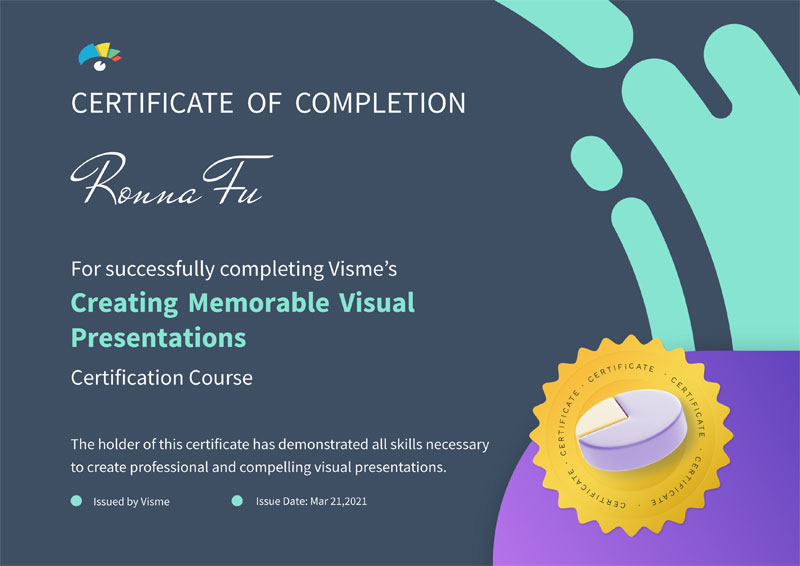

Achieved next stage SEO II with Hubspot. The course covered:
> Google Page Experience and Core Web Vitals
> Improving Your Technical SEO
> SEO for Website Migration
> SEO Performance Analytics
The Page Experience report gives an overview of how users interacted with your website. In order to determine a URL’s ranking in Google Search results, Google analyses page experience characteristics for each individual URL on your website.
Core Web Vitals is a set of metrics that gauges the actual user experience in terms of the page’s visual stability, interactivity, and loading speed.
I would be happy to administer your website and offer any recommendations for changes that can enhance user experience. Feel free to send Ronna an email at contact[at]ronna.com with a brief statement outlining what you require.
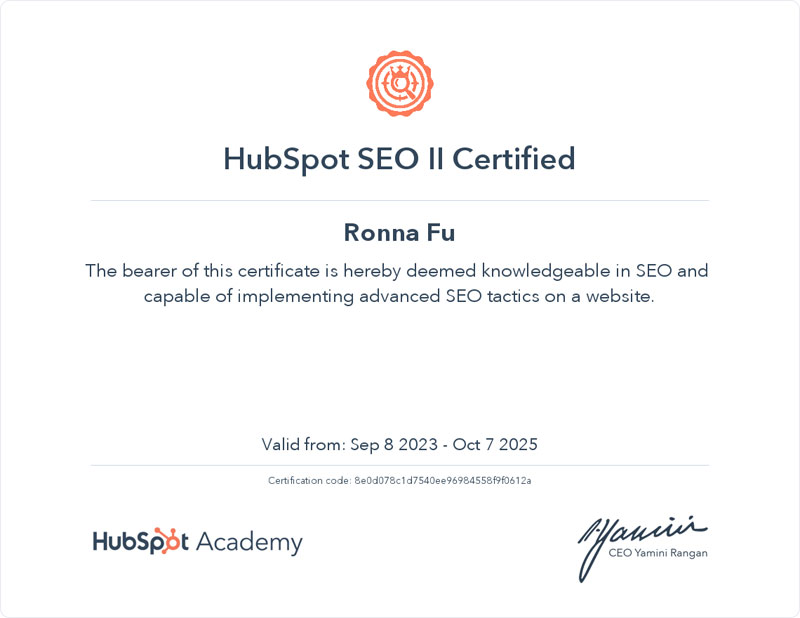
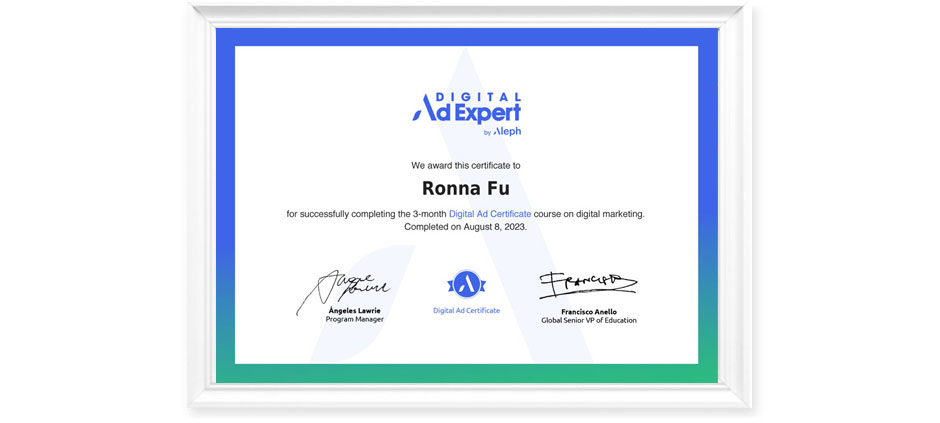
Digital Ad Expert in Digital Marketing is a three months part-time course by Aleph. Digital Marketing is a step-by-step approach to marketing strategy, giving the student the tools to create a precise and successful online marketing campaign. Live classes were held twice a week, and each class lasted 2 hours.
I gained knowledge about every aspect of digital marketing, from its fundamentals to its formal terms, applications, and techniques. The course includes all current data on digital realities to aid in the development of an awareness of the significance of social media in the modern world. I gained knowledge about how this material is consumed and how it affects society, people, brands, and businesses.
The programme covered how to implement a marketing plan with a specific goal. A major goal is to comprehend the range of available marketing objectives. In order to achieve this, we learned to thoroughly understand the company we want to promote in order to decide on the right audience to communicate with and the most effective method.
I have just completed the first SEO (Search Engine Optimisation) training with HubSpot. Moving on to the next step, ie, SEO II. I have been studying more than usual to keep up with social media marketing, SEO and any topics related to equip me serving my customers better.
Below is my certificate of achievement from HubSpot. HubSpot is a digital marketing industry leader, and their blogs, videos, and certification courses are very popular. The cloud-based CRM HubSpot was created to aid in the alignment of sales and marketing teams, promote sales enablement, increase ROI, and optimise inbound marketing strategy to produce more qualified leads.
I would be pleased to manage your website and make any suggestions for adjustments that can enhance user experience. Please feel free to drop Ronna an email and include a brief message describing what you need done.
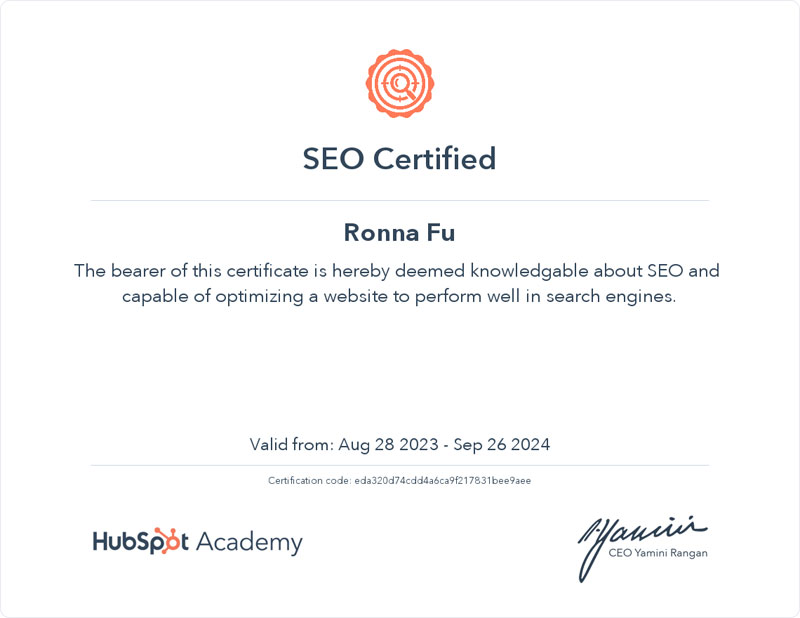
I previously completed a course called SEO Strategies through Great Learning. Great Learning provides online traning on topics like AI, ML, data science, digital marketing, cloud, software engg & more.
The course covers the following topics:
> Introduction to Digital Marketing?
> Why Digital Marketing?
> SEO and working with SEO
> Keyword and SERP Analysis
> Original and Quality Content
> Understanding Local SEO, Optimisation
> Understanding Customer and Performance Matrix
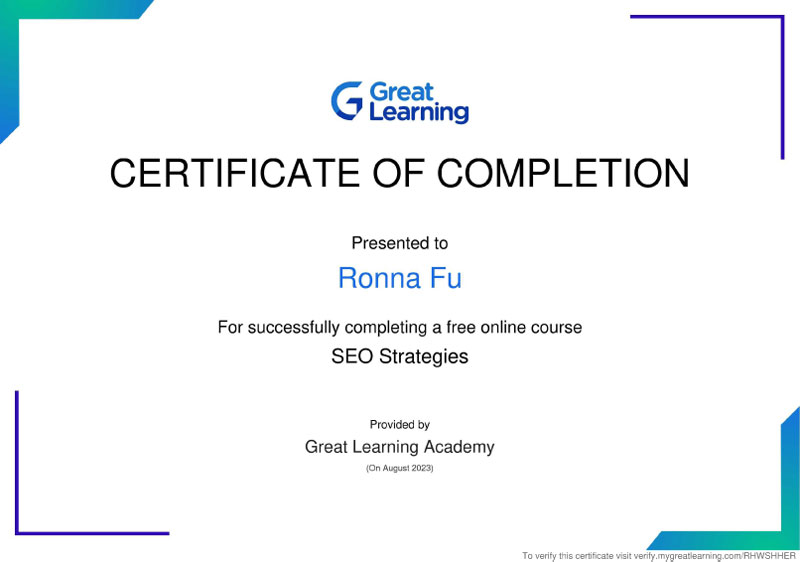
The acronym CSS stands for “Cascading Style Sheets.” In web design and development, it is a style sheet language used to regulate the visual presentation and layout of HTML content. CSS is used to specify how elements of a web page should appear and be placed on screens or other media devices.
The CSS term “cascading” describes how styles are applied in a hierarchy. Styles can be specified at many levels, such as directly within HTML elements, using style tags in the document’s <head>, or in distinct external CSS files.
The way CSS functions is by offering a set of rules that specify distinct stylistic characteristics for specific HTML components. These characteristics range from borders and spacing to colours, typefaces, and more. Web designers and developers can construct consistent and aesthetically pleasing websites while retaining a clear structure by separating the content (HTML) from its presentation (CSS).
Some key concepts of CSS are as follow:
Selectors are patterns that are used to focus on particular HTML components. The items to which the CSS rules will be applied are chosen via selectors.
Values provide the precise style elements that will be altered, such as “colour” or “font-size.” Values are the settings that have been applied to those properties, like “blue” or “16px.”
CSS classes and IDs are used to categorise items and apply particular styling to them. While IDs are intended to serve as specific identifiers for particular items, classes are reusable and can be used to multiple elements.
The box model specifies the content, padding, border, and margin of elements as well as how they are shown. Controlling spacing and layout is essential.
CSS is used to develop responsive web designs, which change to fit various screen sizes and devices. A CSS feature called media queries enables styles to be applied based on the features of the screen.
External style sheets are independent CSS files that can be created and then linked to HTML documents. It is simpler to maintain and update.
CSS attributes have the ability to inherit values from parent elements, enabling uniform styling between nested items.
You can apply styles to particular states of elements (like hovering over a link) or build virtual elements (like putting information before or after an element) using pseudo-classes and pseudo-elements.
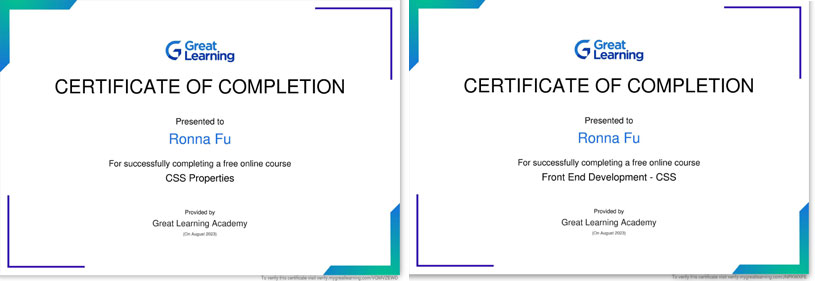
My interest in the subject led me to educational providers like Greater Learning and HubSpot. To stay up to date on the latest in web design, I am continuously researching, learning, and educating myself.
In the realm of design, UI (User Interface) and UX (User Experience) are two terms that are closely related, particularly in the context of software, websites, and applications. They both are essential to creating products that are appealing to the eye, simple to use, and give customers a satisfying experience. They do, however, concentrate on various elements of the design process.
The term “UI” describes the visual components and product design that people directly interact with. It encompasses every visual element that people see and interact with on a screen, such as buttons, menus, forms, typography, colours, icons, and layout. The aim of user interface design is to produce a visually appealing and unified depiction of a product. A user interface (UI) that is well-designed improves the product’s aesthetic appeal and makes it simpler for consumers to explore, comprehend, and interact with the features.
Selecting suitable fonts, symbols, colours, and images that represent the brand and deliver the desired message.
Organising the components on the screen ensuring a balanced and consistent layout by logically and user-friendly
Designing buttons, forms, and other interactive features so that they respond to user inputs in an understandable and natural way is known as interactivity.
Maintaining a coherent and recognisable design language throughout the entire product to achieve consistency.
Giving consumers visible cues as they interact with items, including clicking buttons or submitting forms.
While using a product or service, a user’s overall experience (UX) is the main emphasis of this field of study. It covers every facet of the user’s engagement, such as how simple or complex it is to use, how effectively it satisfies their needs, and if the experience is pleasurable or frustrating. The goal of UX design is to develop products that are user-centered, useful, and beneficial to the user.
Using techniques like surveys, interviews, and usability testing to better understand the wants, needs, and taste of the target market.
The process of structuring and arranging features and material so that users may quickly discover what they need.
Drawing out a diagram of the routes customers travel through the system to complete particular tasks, pointing out problems and potential improvements.
Making low- or high-fidelity prototypes allows you to visualise and test various design concepts prior to actual development.
It involves obtaining input from actual users in order to pinpoint problems and improve the design in light of their interactions and feedback.
In conclusion, UI and UX are essential elements of the design process and each serves create products that are not only aesthetically pleasing but also easy to use and pleasurable to employ. Finding the ideal balance between UI elements that grab the user’s attention and UX guidelines that guarantee a seamless and successful user experience is essential for successful design.
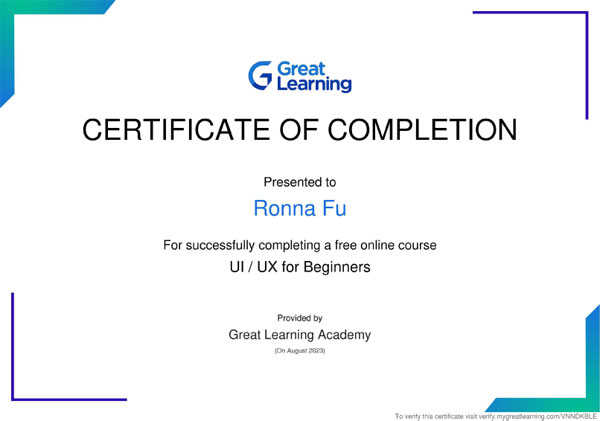
A Google Search campaign is a particular type of online marketing campaign that runs through Google Ads, formerly known as Google AdWords, Google’s platform for online marketing. When consumers conduct a Google search for a certain keyword, text advertising are intended to be displayed to them.
Google Search campaigns are an effective approach to reach people who are looking for items or services similar to yours right now. They enable you to connect with a very targeted audience and track the success of your campaign using statistics like clicks, impressions, click-through rate (CTR), and conversion rate.
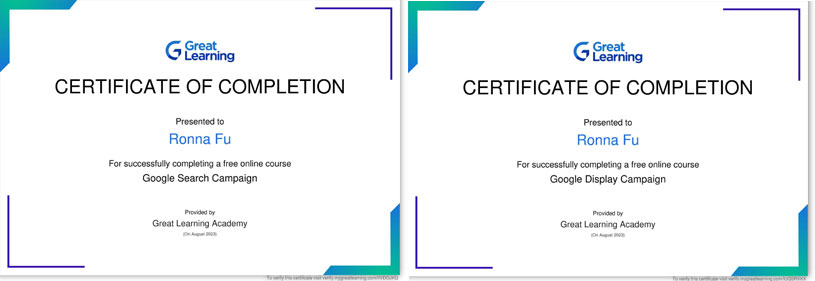
Choosing keywords that are pertinent to your enterprise, goods, or services is the first step in conducting keyword research. These are the terms and phrases that customers might type into the Google search box to find products and services similar to yours.
You produce text-based advertisements that are pertinent to the selected keywords. Every advertisement normally has a headline, a few lines of information, and a display URL.
The maximum bid that you set for each term is what you’re willing to spend when someone clicks on your ad. The position of your ad on the search results page is determined by this bid together with other elements like ad relevancy and quality score.
Google’s Ad Rank algorithm determines the position of the adverts on the search results page. Your bid, ad quality, anticipated click-through rate, ad relevancy, landing page experience, and other variables are used to determine your ad rank.
Google’s algorithm chooses which advertisements to display when consumers search for a keyword you’re targeting depending on the Ad Rank. Depending on the competition and your bid, your ad may appear at the top, bottom, or side of the search results page.
The cost-per-click (CPC) bidding mechanism determines how much you are charged if a user clicks on your advertisement. The most you’re willing to spend on the campaign is your budget.
A user is taken to a landing page on your website when they click on your advertisement. The landing page should give a positive visitor experience and be pertinent to the advertisement.
You keep an eye on the campaign’s effectiveness using the reporting tools provided by Google Ads. To increase the effectiveness of the campaign, you can change bids, add new keywords, halt underperforming advertisements, and execute other optimisations.
This summer, I enrolled in as many courses as I could to increase my understanding of every facet of marketing. My most recent courses were Email Marketing and AI Marketing.
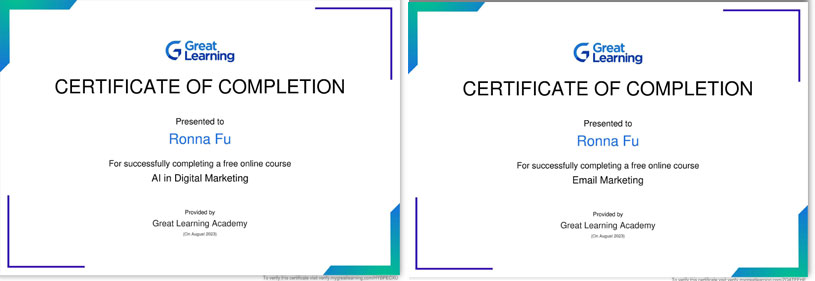
When done right, Email Marketing can be a powerful instrument for establishing and fostering customer relationships, boosting revenue, and preserving brand engagement. To get the best outcomes, it is critical to regularly modify your plans based on subscriber behaviour and market trends.
Here are some key aspects and best practices of Email Marketing:
The first step in creating a subscriber list is to compile a list of people who have granted you consent to send them emails. Website sign-up forms, social media, events, and other lead generating techniques can all be used to do this.
Individual subscribers are not all created equal. Segment your email list according to several factors, such as demographics, interests, behaviours, or past purchases. This enables you to send each segment more pertinent and customised material.
Subscribers should be addressed by name, and content should be tailored to their preferences. Emails that are personalised typically have greater open and engagement rates.
Provide your subscribers with worthwhile and pertinent information. This could consist of product updates, informational materials, special deals, or market insights.
Your email’s subject line is what persuades recipients to open it. Make sure it is compelling, clear, and concise.
Your emails should be designed for mobile viewing since many consumers check their emails on mobile devices.
A crystal-clear CTA should be included in every email. Make it simple for recipients to perform the required activity, whether it’s to buy something, read an article, register for an event, or download something.
Test several aspects of your emails on a regular basis to evaluate what works best, including subject lines, content, CTAs, and sending times. To evaluate the success of your efforts, use analytics to analyse open rates, click-through rates, conversion rates, and other data.
Make sure you have permission to send emails to your subscribers and that your emails adhere to anti-spam legislation (such the CAN-SPAM Act). Additionally, stay away from overusing capitalization, overusing graphics, and specific terms that could set off spam filters.
To send emails, strike the perfect mix between frequency and quality. Too many emails can force subscribers to unsubscribe, while too few can make them forget about you.
Make sure you always provide subscribers with a simple way to unsubscribe from your emails. As a result, trust is increased and it is easier to keep an active subscriber base.
Utilise email marketing systems with automation features. With the help of triggers like user actions or dates, you may create automatic email sequences.
AI Marketing, also known as artificial intelligence marketing, refers to the use of artificial intelligence (AI) and machine learning techniques to enhance and optimize various aspects of marketing strategies and campaigns. AI has the potential to transform how businesses engage with their customers, analyze data, and make data-driven decisions to improve overall marketing effectiveness.
While AI can have a positive impact on marketing, it is vital to remember that there is no one-size-fits-all AI solution. To ensure that the technology is in line with the overall marketing strategy and produces the expected outcomes, the implementation of AI in marketing necessitates thorough planning, integration with existing systems, and continual monitoring.
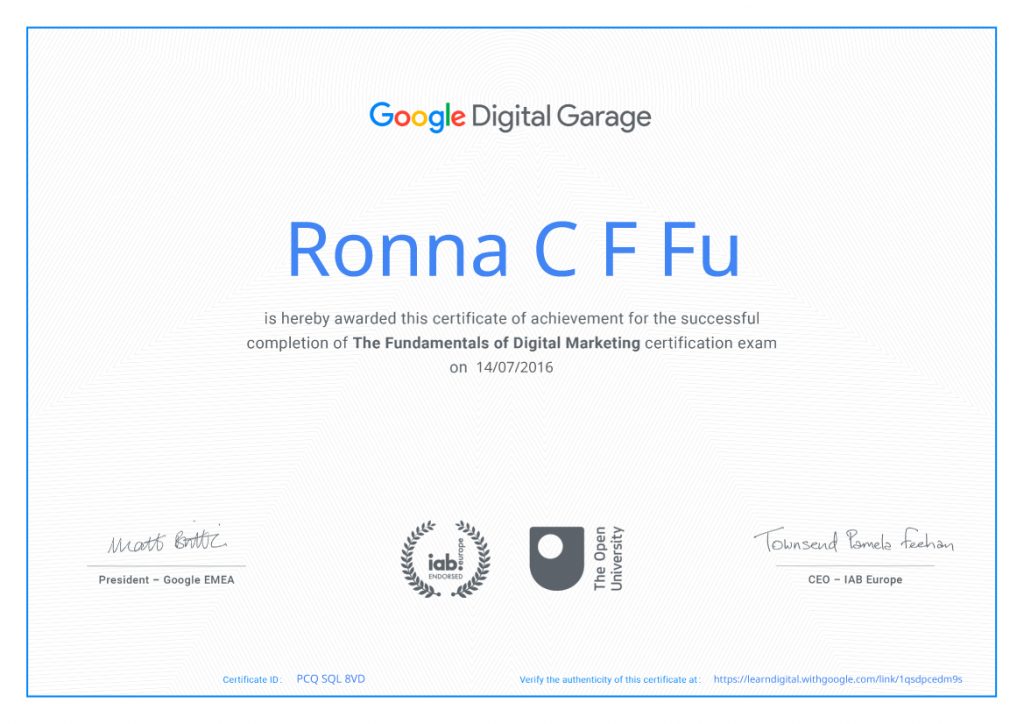
The Fundamentals of Digital Marketing Certification. A forty hours and twenty-six modules course by Google.
The Online Opportunity
Your First Steps in Online Success
Build Your Web Presence
Plan YOur Online Business Strategy
Make it Easy for People to Find A Business on the Web ( 5 topics)
1. Get Started with Search
2. Get Discovered with Search
3. Make Search Work for You
4. Be Noticed with Search Ad
5. Improve Your Search Campaign
Reach More People Locally, On Social Media or on Mobile (7 topics)
1. Get Noticed Locally
2. Help People Nearby Find You Online
3. Get Noticed With Social Media
4. Deep Dive Into Social Media
5. Discover the Possibilities of Mobile
6. Make Mobile Work for You
7. Get Started with Content Marketing
Reach more customers with advertising ( 4 topics)
1. Connect Through Emails
2. Advertise on Other Websites
3. Deep Dive Into Display Advertising
4. Make the Most of Videos
Track and measure web traffic (3 topics)
1. Get Started with Analytics
2. Find Success with Analytics
3. Turn Into Insights
Sell products or services online (2 topics)
1. Buld Your Online Shop
2. Sell More Online
Take a business global (1 topic)
1. Expand Internationally
I completed a course in creating presentations, documents, data visualizations, videos and other branded contents using Visme. Visme is a powerful online tool that allows users to create, edit, share, and store visual content. It may be uses as a presentation programme to create slide decks, but you can also design templates for visuals for letterheads, infographics, charts, logos, and storyboards.
